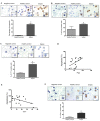Correlation of the expression of YY1 and Fas cell surface death receptor with apoptosis of peripheral blood mononuclear cells, and the development of multiple organ dysfunction in children with sepsis
- PMID: 28447715
- PMCID: PMC5428261
- DOI: 10.3892/mmr.2017.6310
Correlation of the expression of YY1 and Fas cell surface death receptor with apoptosis of peripheral blood mononuclear cells, and the development of multiple organ dysfunction in children with sepsis
Abstract
Multiple organ dysfunction (MOD) is a lethal complication in children with sepsis. Apoptosis of several cell types is involved in this process, and it is associated with increased Fas cell surface death receptor (Fas) expression. As YY1 transcription factor (YY1) negatively regulates the expression of Fas in cancer models, and is associated with the clinical outcome, it may be important in MOD. The present study aimed to determine the association between the expression of Fas, YY1 and apoptosis in children with sepsis, and its association with MOD, these factors were analyzed in 30 pediatric patients that had been diagnosed with sepsis. Peripheral blood mononuclear cells were purified from patients, and YY1 and Fas protein expression was assessed by immunocytochemistry. Apoptosis was determined by terminal deoxynucleotidyl transferase dUTP nick‑end labeling. Sepsis was monitored using clinical parameters, pediatric logistic organ dysfunction (PELOD) score and the pediatric mortality index. The results demonstrated that Fas expression was directly correlated with apoptosis levels and the expression of YY1 was inversely correlated with apoptosis levels. Patients with high levels of apoptosis exhibited increased disease severity and poor clinical outcome. Notably, the findings of the present study demonstrated that there were higher survival rates in patients with high YY1 expression, compared with those with low YY1 expression. Additionally, patients with MOD exhibited lower proportions of apoptotic cells compared with sepsis patients without MOD. Furthermore, the PELOD score was positively correlated with Fas and inversely correlated with YY1 expression. Finally, high apoptosis and low YY1 expression were prognostic factors associated with poor survival rates. These data suggested that YY1 may be important for apoptosis induction via the regulation of Fas during sepsis. Therefore, Fas may be a potential therapeutic target to prevent MOD through regulation of YY1 expression. Furthermore, YY1 and Fas expression in PBMCs may be used to as prognostic markers.
Figures





Similar articles
-
Soluble fas levels correlate with multiple organ dysfunction severity, survival and nitrate levels, but not with cellular apoptotic markers in critically ill patients.Shock. 2000 Aug;14(2):107-12. doi: 10.1097/00024382-200014020-00005. Shock. 2000. PMID: 10947151
-
Yin-Yang-1 decreases Fas-induced apoptosis in acute lymphoblastic leukemia under hypoxic conditions: its implications in immune evasion.Bol Med Hosp Infant Mex. 2020;77(4):186-194. doi: 10.24875/BMHIM.19000187. Bol Med Hosp Infant Mex. 2020. PMID: 32713953 English.
-
Involvement of the TNF-alpha autocrine-paracrine loop, via NF-kappaB and YY1, in the regulation of tumor cell resistance to Fas-induced apoptosis.Clin Immunol. 2006 Sep;120(3):297-309. doi: 10.1016/j.clim.2006.03.015. Epub 2006 Jun 19. Clin Immunol. 2006. PMID: 16784892
-
Inverse correlation between the metastasis suppressor RKIP and the metastasis inducer YY1: Contrasting roles in the regulation of chemo/immuno-resistance in cancer.Drug Resist Updat. 2017 Jan;30:28-38. doi: 10.1016/j.drup.2017.01.001. Epub 2017 Jan 9. Drug Resist Updat. 2017. PMID: 28363333 Review.
-
Leukocyte apoptosis and its significance in sepsis and shock.J Leukoc Biol. 2005 Aug;78(2):325-37. doi: 10.1189/jlb.0105017. Epub 2005 Apr 7. J Leukoc Biol. 2005. PMID: 15817707 Review.
Cited by
-
RKIP: A Key Regulator in Tumor Metastasis Initiation and Resistance to Apoptosis: Therapeutic Targeting and Impact.Cancers (Basel). 2018 Aug 24;10(9):287. doi: 10.3390/cancers10090287. Cancers (Basel). 2018. PMID: 30149591 Free PMC article. Review.
-
miR-145a Regulation of Pericyte Dysfunction in a Murine Model of Sepsis.J Infect Dis. 2020 Aug 17;222(6):1037-1045. doi: 10.1093/infdis/jiaa184. J Infect Dis. 2020. PMID: 32285112 Free PMC article.
-
miR‑29a suppresses IL‑13‑induced cell invasion by inhibiting YY1 in the AKT pathway in lung adenocarcinoma A549 cells.Oncol Rep. 2018 Jun;39(6):2613-2623. doi: 10.3892/or.2018.6352. Epub 2018 Apr 4. Oncol Rep. 2018. PMID: 29620222 Free PMC article.
-
Identification of specific feed-forward apoptosis mechanisms and associated higher survival rates for low grade glioma and lung squamous cell carcinoma.J Cancer Res Clin Oncol. 2018 Mar;144(3):459-468. doi: 10.1007/s00432-017-2569-1. Epub 2018 Jan 5. J Cancer Res Clin Oncol. 2018. PMID: 29305708 Free PMC article.
-
Expression of PIM-1 in salivary gland adenoid cystic carcinoma: Association with tumor progression and patients' prognosis.Oncol Lett. 2018 Jan;15(1):1149-1156. doi: 10.3892/ol.2017.7408. Epub 2017 Nov 14. Oncol Lett. 2018. PMID: 29399171 Free PMC article.
References
-
- Rayo AC, Hernández GL, Huerta GL, Ortiz AV, Reyes RM, Gómez RG. Mecanismos patogénicos en sepsis y choque séptico. Med Interna Mex. 2008;24:38–42.
-
- Carrillo-Esper R, Carrillo-Cordova JR, Carrillo-Cordova LD. Epidemiological study of sepsis in Mexican intensive care units. Cir Cir. 2009;77:279–385. (In Spanish) - PubMed
Publication types
MeSH terms
Substances
LinkOut - more resources
Full Text Sources
Other Literature Sources
Medical
Research Materials
Miscellaneous

